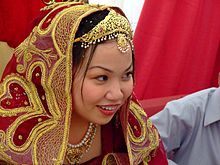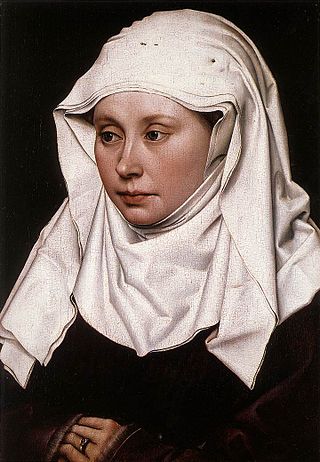
A wimple is a medieval form of female headcovering, formed of a large piece of cloth worn draped around the neck and chin, covering the top of the head; it was usually made from white linen or silk. Its use developed in early medieval Europe; in medieval Christianity it was unseemly for a married woman to show her hair. A wimple might be elaborately starched, creased and folded in prescribed ways. Later elaborate versions were supported on wire or wicker framing, such as the cornette.

A hat is a head covering which is worn for various reasons, including protection against weather conditions, ceremonial reasons such as university graduation, religious reasons, safety, or as a fashion accessory. Hats which incorporate mechanical features, such as visors, spikes, flaps, braces or beer holders shade into the broader category of headgear.

A red carpet is traditionally used to mark the route taken by heads of state on ceremonial and formal occasions, and has in recent decades been extended to use by VIPs and celebrities at formal events.

A coif is a close fitting cap worn by both men and women that covers the top, back, and sides of the head.

A headband is a clothing accessory worn in the hair or around the forehead, usually to hold hair away from the face or eyes. Headbands generally consist of a loop of elastic material or a horseshoe-shaped piece of flexible plastic or metal. They come in assorted shapes and sizes and are used for both fashion and practical or utilitarian purposes.
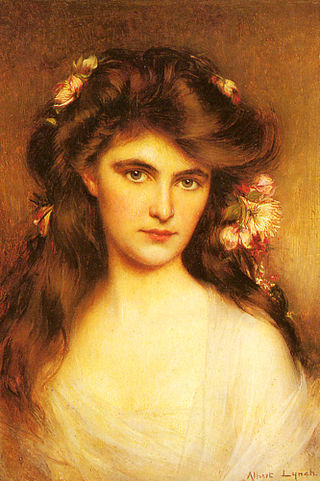
A bouffant is a type of puffy, rounded hairstyle characterized by hair raised high on the head and usually covering the ears or hanging down on the sides.
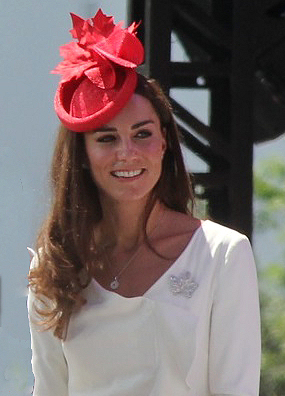
A fascinator is a formal headpiece, a style of millinery. Since the 1990s, the term has referred to a type of formal headwear worn as an alternative to the hat; it is usually a large decorative design attached to a band or clip. In contrast to a hat, its function is purely ornamental: it covers very little of the head and offers little or no protection from the weather. An intermediate form, incorporating a more substantial base to resemble a hat, is sometimes called a hatinator.

A flight helmet, sometimes referred to as a "bone dome" or "foam dome", is a special type of helmet primarily worn by military aircrew.

Icelandic national costume, collectively known in Icelandic as Þjóðbúningurinn has enjoyed various levels of popularity since the term was coined in Iceland in the 19th century, during the struggle for independence. Since 2001 the national costume is regulated by Þjóðbúningaráð, which preserves the correct techniques of making them and instructs people.
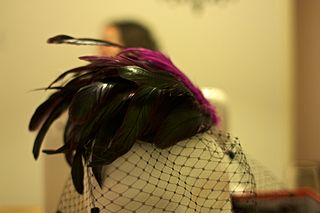
A cocktail hat is a small, extravagant, and typically brimless hat for a woman. It is usually a component of evening wear and is intended as an alternative to a large-brimmed hat. These hats are often decorated with beads, jewels or feathers, as well as a veil or netting. Cocktail hats were most popular between the 1930s and 1960s.

In Spain and in the rest of the Hispanic world, a peineta is a large decorative comb usually worn under a mantilla, or lace head covering.
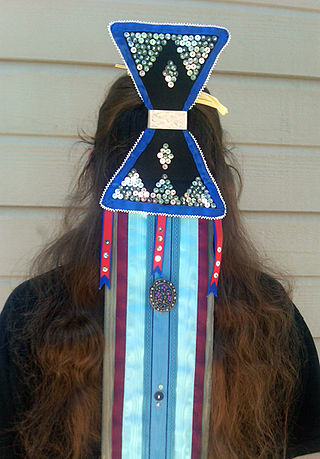
A dush-toh, also spelled dush-too, dush-tooh, or dush-tuh, is a customary Caddo hair ornament worn by girls and women during dances, particularly the Turkey Dance. Neighboring tribes, such as the Kickapoo and Delaware, have similar women's hair ornaments.

A jang-ot, also known as janot, jang-eui, jang-ui (장의/長衣), is a type of po worn by women of the Joseon Dynasty period as a headdress or veil to cover their faces by the mid-18th century. They were mostly worn by commoners but not exclusively. Jang-ot was originally a form of men's po called jang-ui, which was worn in 15th century. The jang-ui started to be worn by women as an overcoat in early Joseon, even becoming a popular fashion item for women of high status. It was previously one of the most representative women's overcoats; it was worn as a women's overcoat when they would leave their house until the 17th century.

Headgear, headwear, or headdress is any element of clothing which is worn on one's head, including hats, helmets, turbans and many other types. Headgear is worn for many purposes, including protection against the elements, decoration, or for religious or cultural reasons, including social conventions.

A radiant or radiate crown, also known as a solar crown, sun crown, Eastern crown, or tyrant's crown, is a crown, wreath, diadem, or other headgear symbolizing the Sun or more generally powers associated with the Sun. Apart from the Ancient Egyptian form of a disc between two horns, it is shaped with a number of narrowing bands going outwards from the wearer's head, to represent the rays of the Sun. These may be represented either as flat, on the same plane as the circlet of the crown, or rising at right angles to it.

A halo hat is a millinery design in which the headgear acts as a circular frame for the face, creating a halo effect. The design is said to date back to the late 19th century, when it was known as the aureole hat; this name is sometimes still used. It may also be known as the angel hat or bambini – the latter said to derive from Italian for terracotta plaques depicting the infant Christ.

The keffiyeh or kufiyya, also known in Arabic as a ghutrah (غُترَة), shemagh, or ḥaṭṭah (حَطَّة), is a traditional headdress worn by men from parts of the Middle East.

Gargush is a traditional Yemenite Jewish headdress, resembling a hood, which is thought to have originated in the Sanaite community.

Liangbatou or Erbatou is a hairstyle/headdress worn by Manchu women. It is a tall headdress that features two handfuls of hair, parted to each side of the head, sometimes with the addition of wire frames, extensions and ornamentation.

The sseugaechima is a kind of headwear that noble Korean women used during the middle and end of the Joseon dynasty (1392–1897) to cover their faces. As Confucian ideals became stronger, women were required to hide their faces from men when leaving the house. There were several kinds of headdresses that the Joseon women used according to their ranks: the neoul was used by the court women, the sseugaechima was used by the yangban women; and the jang-ot was used by the jungin women or commoners. The sseugaechima was a piece of clothing in the shape of a skirt and was mainly made from cotton or silk.
